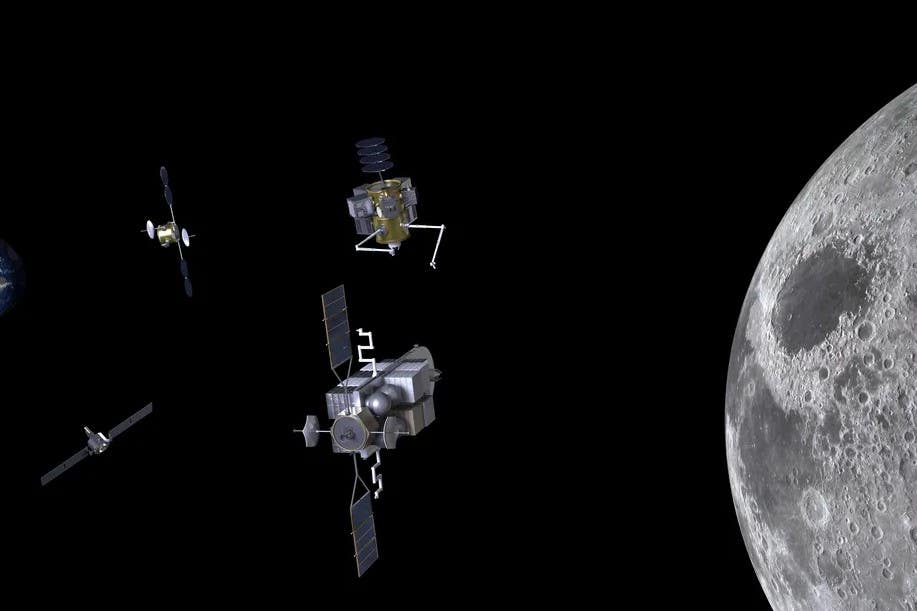Space startup looks to build a robotic outpost near the Moon
At the center of the new company is an evolvable and scalable space platform, called a robotic outpost, that will serve multiple users.

[Dec 8, 2022: JD Shavit, The Brighter Side of News]
An artistic rendering of the robotic outpost, servicing satellite, and other pathfinder vehicles that Quantum Space hopes to build. (CREDIT: Quantum Space)
With a focus on rapid technological advancement and lowering the cost to access cis-lunar space, a quartet of space veterans are launching Quantum Space, a commercial space infrastructure and services company aimed at disrupting the current norms of the satellite industry.
At the center of the new company is an evolvable and scalable space platform, called a robotic outpost, that will serve multiple users with deploying satellites, hosting payloads and acquisition of data and logistics services via customizable missions from locations in lunar and Earth orbits.
The three co-founders are Kam Ghaffarian, a space and energy entrepreneur whose co-founded many leading new space companies, Steve Jurczyk, the former NASA Acting Administrator, and Ben Reed, former division chief of NASA’s Exploration and In-Space Services at Goddard Space Flight Center.
They are joined by Kerry Wisnosky, the co-founder and former principal owner of Millennium Engineering and Integration. Each has over 30+ years of experience in aerospace developing, launching, and operating complex space systems. The trio saw a need in the market to lower operating costs, drive more rapid innovation and efficiently enable new space capabilities.
Related Stories
Jurczyk, who is the president and CEO of the company, says Quantum Space is focused on the Moon since NASA is also focused on returning there. The space agency’s primary human spaceflight enterprise at the moment is Artemis, a massive initiative to send the first woman and the first person of color to the lunar surface.
Along with performing a series of human landings, NASA is also partnering with various commercial companies to send a fleet of landers and rovers to the Moon to explore the environment. Given all of these proposed lunar missions, Quantum Space felt like there was an opportunity to create vehicles that could be useful in the area.
“We know there’s going to be a lot of activity around and on the Moon in the coming decade, primarily driven by Artemis,” Jurczyk said. “But you know, national security — where civil spaces goes, national security will have to go also.” Jurczyk anticipates Space Force and other military entities might leverage NASA’s lunar exploration and become customers in the future.
The Quantum Space Robotic Outpost. The Outpost will provide robotics capability for visiting vehicle rendezvous and capture, payload swapping, test bed activities and refueling. (CREDIT: Quantum Space)
‘We envision a future where innovation and sustainability meet propelling human progress, economic growth and expanding access to space, and its vast ability to improve life on Earth. Quantum Space will be a leader in building this new future by rethinking how we approach spacecraft and space services,” said Ghaffarian, co-founder and Executive Chairman of Quantum Space.
Ghaffarian is providing the seed funding for this new space company and has a strong background co-founding and funding successful deep-tech startups such as Axiom Space, building the world’s first commercial space station, Intuitive Machines, creating the first American Lunar Lander in 50 years, and X-energy, an advanced nuclear power company.
In 2024, QS-1 will be the first step in establishing a superhighway between the Earth and the Moon by deploying commercial capabilities that enable spacecraft to operate in and travel through cislunar space and beyond more effectively and efficiently. (CREDIT: Quantum Space)
Jurczyk says he envisions multiple types of vehicles that Quantum Space can build in the coming years to aid with the future influx of Moon missions. First, the company hopes to create a robotic outpost that could potentially help with communication in the region of space between regular Earth orbits and the Moon, known as cislunar space.
NASA has a concept for creating an internet-like system of communications infrastructure around the Moon called LunaNet, which would be less reliant on Earth technologies for navigation, communication, and data relays. Jurczyk says his company’s robotic outpost could be involved. “We believe we can be a node or nodes in that network, for both spacecraft in orbit as well as spacecraft on the surface,” he says.
Along with communications, the outpost could also do observations of Earth or the lunar surface, as well as host payloads for collecting data on the lunar environment. The company also envisions providing space traffic services for spacecraft traveling around the Moon.
There are also options to observe the climate of Earth from a unique vantage point, as well as characterize near-Earth objects like asteroids. Quantum Space sees its outpost being at a specific point in space between the Earth and the Moon known as an Earth-Moon Lagrange point, where the gravity and centripetal forces between the two bodies are just right for spacecraft to remain relatively stable. The particular Lagrange point that Quantum Space is aiming for is called L1, and it’s about 38,100 miles from the Moon’s surface.
Founded in 2021, Quantum Space focuses on hosting and deploying payloads and providing data and logistics services from unique vantage points, a critical location for economic and national security purposes. The company plans to rapidly expand space services with additional outposts at various orbits. With its modular in-space infrastructure, Quantum Space plans to be a key player in addressing space sustainability with their multi-user, mutli-mission model.
“We aim to remove barriers to entry for utilizing space to deliver more science, more data and information, strengthen national security, and accelerate commercial activities. Our business model which allows customers to purchase services on an as needed basis will enable new entrants and markets by reducing costs and allowing more rapid access to strategically important locations” said Jurczyk.
Quantum Space is leading development of the space superhighway with the deployment of commercial capabilities — to provide data, perform future payload hosting, in-space testbed, deploy spacecraft, and perform in-space logistics services for our partners. (CREDIT: Quantum Space)
Right now, the company is working toward a pathfinder mission that would send a test robot to the Earth-Moon Lagrange point as early as spring of 2024. The goal would be to demonstrate many of the capabilities that Quantum Space’s future outpost would do, such as Earth and lunar observations, communication capabilities, and more.
It’s a lot to do within the next two years, but there may be quite a bit more time before NASA’s exploration of the Moon picks up. The space agency was eyeing its first human lunar landing in 2024, but recently delayed that to 2025 at the earliest. With key rockets and hardware for Artemis facing repeated delays, there should be ample time to flesh out the cislunar space economy.
Note: Materials provided above by The Brighter Side of News. Content may be edited for style and length.
Like these kind of feel good stories? Get the Brighter Side of News' newsletter.
Joseph Shavit
Head Science News Writer | Communicating Innovation & Discovery
Based in Los Angeles, Joseph Shavit is an accomplished science journalist, head science news writer and co-founder at The Brighter Side of News, where he translates cutting-edge discoveries into compelling stories for a broad audience. With a strong background spanning science, business, product management, media leadership, and entrepreneurship, Joseph brings a unique perspective to science communication. His expertise allows him to uncover the intersection of technological advancements and market potential, shedding light on how groundbreaking research evolves into transformative products and industries.



